
The first people probably arrived in Ireland during the Mesolithic period, shortly after the end of the last Ice Age, that is to say around 10,000 years ago. They probably arrived via a land bridge that connected Ireland to what is now Pembroke in South Wales. Until recently it was thought that during the 1st Millennium B.C. these people were largely supplanted by the Celts but modern opinion is that that there was no invasion as such, simply that Celtic culture was gradually absorbed over a considerable period due to contact with traders from Continental Europe as sea travel improved. The extent of this influence can be seen from the fact that the Irish Goedelic language, which eventually gave rise to Gaelic, was related to Celtic.
The Romans, when they invaded Britain, were aware of Ireland, and called it Hibernia, though the early geographers such as Ptolemy erred with regards to its position, mistakenly believing it lay between Britain and Spain. The historian Tacitus, in the Agricola, XXIV, refers to an Irish prince driven from his home by a rebellion who had taken refuge with the Romans. It is difficult to judge the extent of contact with Ireland during the 400 years that Britain was under Roman occupation, but some Roman coins have been discovered in the island, acquired during trade.
During the 5th Century A.D. the people of Ireland were converted to Christianity and by the Anglo-Saxon period the Irish Church was so well-established, that it sent a mission to convert the kingdom of Northumbria in England. The following three hundred years of relative peace and prosperity were a golden age for Ireland; one remarkable cultural treasure from this period, circa A.D. 800, is the Book of Kells, now displayed in Trinity College, Dublin. This period of peace ended abruptly with the arrival of the Vikings. They had first attacked England in A.D. 787 and now began to arrive in Ireland. Although they first came to loot and pillage, it was not long before they began to settle in the area around Dublin and other places in the south east of the island, at Limerick, Wexford, Waterford and Cork. The Viking period lasted around 400 years and it was they who first produced an indigenous coinage. Prior to that both Scandinavian and English coins had been in circulation. Although they came as invaders it was not long before the Vikings intermarried with the Irish and adopted their language and dress, at the same time converting to Christianity.
Around A.D. 995 the Vikings began striking imitations of the silver pennies of the English king, Aethelred II (“Aethelred the Unready”). At first these Hiberno-Norse coins were of a fairly good standard but the later issues, modelled on coins of Cnut (1016-1035), Harthacnut (1035-1042), Edward the Confessor (1042-1066) and William I (1066-1087), were poorly made and low weight. By the early 12th Century, the coins were so thin that they became bracteates, struck so that one side had a raised impression and the other side incused with the same design. By then Viking influence in Ireland had seriously declined.
This was the moment when the Normans invaded Ireland, led by Richard de Clare, Earl of Pembroke. This development caused the English king, Henry II, great concern and, with papal blessing, he entered into an agreement with the Irish petty kings in which they agreed to submit to his rule as long as he protected them from the ravages of the Norman barons, and given the title of Lord of Ireland.
John de Courcy became Earl of Ulster in 1181 and for approximately ten years, from 1185 to 1195, he minted silver halfpennies and farthings. When Prince John succeeded his father Henry II as Lord of Ireland in 1172, he also minted halfpennies and farthings. All these coins are extremely rare. After John became King of England in 1199 he had de Courcy declared an outlaw and made Hugh de Lacy Lord of Ulster in his place. John and his two successors, Henry III (1216-1272) and Edward I (1272-1307) all issued silver pennies as well as some more halfpennies and farthings as Kings of England and Lords of Ireland. These coins were distinguished by having the portrait of the king contained within a triangle. The principal mint was Dublin, but some were struck at Limerick, Waterford, and Cork. During the reign of John halfpennies were also minted at Carrickfergus, Downpatrick and Kilkenny. As with English coins from the same period, they were extensively imitated and counterfeited on the Continent and any found with blundered legends almost certainly contemporary forgeries.

Silver penny of Edward I minted in Dublin (Civitas Dvblinie)
After 1302 no coins were minted in Ireland for over a century, except for a few rare halfpence during the reign of Edward III (1327-1377). This was the opposite of what was happening in England and, to an extent, Scotland, where a healthy trade had begun to develop with the Continent and with it a money-based economy. The neglect of the monetary needs of Ireland is a reflection of how relatively unimportant it was from the point of view of the English, who regarded it as something of a primitive backwater1, an attitude which was to persist for another 500 years.
Although some rare pennies were struck in Ireland during the reign of Henry VI2 (1422-1461) it was not until the reign of his successor, Edward IV that the Anglo-Irish Parliament decided it was time to resume minting again, necessitated by an acute shortage of coins that had gradually arisen over the intervening decades. The principal coin minted was the silver groat, valued at four pennies, a denomination which, although not unknown to Ireland,had been in circulation in England since 1351 in the time of Edward III. The other coins minted were the half-groat (two pence), penny, halfpenny and farthing. These coins were all deliberately minted so that their face value was higher than the silver content, to deter the practice of melting them down and exporting the silver to the Continent, as was commonly done with English coins. Several mints were involved, Dublin being the most important, including Cork, Drogheda, Limerick, Trim and Waterford. This coinage continued in the following reigns of Richard III and Henry VII. Under Richard there began the practice of depicting a shield of arms in place of the portrait of the king. Other coins were minted by Lambert Simnel and the Earl of Kildare during a brief rebellion against Henry VII.
Simnel was a boy of humble origin passed off as one of the two sons of Edward IV who had been imprisoned in the Tower of London3 by Richard III. His tutor, a priest called Roger Simon4, took him to Ireland and persuaded the head of the Irish Government, Gearoid Mór Fitzgerald, Earl of Kildare, that Simnel was the rightful heir to the throne. Simnel was crowned king in Christ Church Cathedral, Dublin, on 24 May 1487. On 5 June the Irish army, reinforced by 2000 Flemish mercenaries, landed in the north west of England. In a battle fought against the army of Henry VII at Stoke Field in Nottinghamshire the Irish were soundly beaten. Simnel, Simon and Kildare were all captured. Subsequently all three were spared, though Simon remained in prison for the remainder of his life. Kildare was later appointed Lord Deputy of Ireland by Henry VII.
After the death of Henry VII no coins were struck in Ireland until 1547. The Irish coinage of his successor, Henry VIII (1509-1547) was actually minted in either London or Bristol and shipped to Ireland. These groats and half-groats show the Royal Arms on the obverse and a harp on the reverse and as a consequence are known as the “Harp” coinage. This was triggered by events in England when Henry, wishing to rid himself of his wife Catherine of Aragon so that he could marry Anne Boleyn, was angered by the Pope’s refusal to grant him a divorce. Thus began the Reformation under which England broke away from the Roman Catholic Church and Papal control. Henry declared himself to be the head of the Church of England and began the process of dissolving the monasteries and other religious establishments and sequestering all their assets. This defiance of the Pope brought Henry into conflict with other rulers in Europe and in particular, Philip II of Spain, who began to intrigue with the Irish, who remained Catholic, in order to use them in a possible war against England. Henry’s response was to declare himself King of Ireland and on his second coinage,from 1540-1542, his title changed from HENRIC(us) VIII D(ei).G(ratia).R(ex) A(n)GL(iae). Z(=et) FRANCE DOMINUS HIBERNIE to HENRIC VIII D.G.R. AGL. Z FRANCE ET HIBERNIE REX. A feature of some of these coins was the association with his current wife by placing her initial as well as his own either aside of the harp on the reverse, H and A (Henry and Anne Boleyn), H and I (Henry and Jane Seymour) and H and K (Henry and Katherine Howard). A sharp rise in the price of silver in the last years of his reign meant that the groat was revalued as six pence (this despite the fineness having declined to only 25% silver) and the half-groat as three pence.
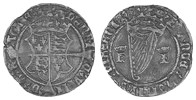
"Harp coinage" silver groat of Henry VIII with his own initial (H) and that of Jane Seymour (I)
Following the death of Henry, some posthumous coins with his name were struck at Dublin, reopened by his son Edward VI. The larger silver coins, although referred to as groats, continued to be valued at six pence, hence there were also smaller silver coins of three pence and three halfpence, all with the name and portrait of Henry VIII. There were no groats bearing the name of the boy king. Edward VI also introduced a larger denomination, the shilling, valued at twelve pence (and hence two groats), which were the first Irish coins to bear a date, MDLII (1552). Like the groat this was made of base silver and later, in the time of Elizabeth I when the English shilling had been restored to its former standard of 0.925 fine, base silver shillings from earlier in her reign were sent to Ireland for circulation at a reduced tariff.
The first coinage of Mary (1553-1558) consisted of shillings, groats, half-groats and pennies with an increased silver content of 58.3%. This attempt to increase the fineness was short-lived and coins minted after her marriage to Philip II of Spain in 1554 reverted to only 25% silver. The early issues of Elizabeth I (1558-1603) were similarly of base silver, though some minted in 1561 were struck 0.916 fine. There was another base silver issue of shillings, sixpences and threepences right at the end of her reign (1601-1602). These, together with copper pennies and halfpence, were minted in order to pay troops stationed in Ireland. During the last 50 years or so of the Tudor period there was a deliberate policy of not supplying good quality silver to Ireland because its loyalty was always suspect and and so prevent the silver being used to finance a rebellion.
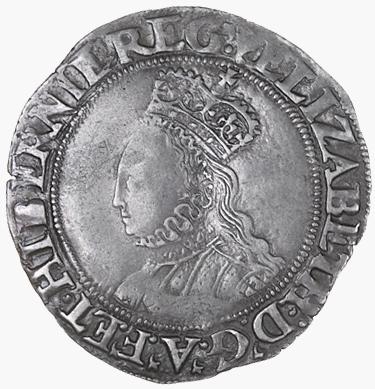
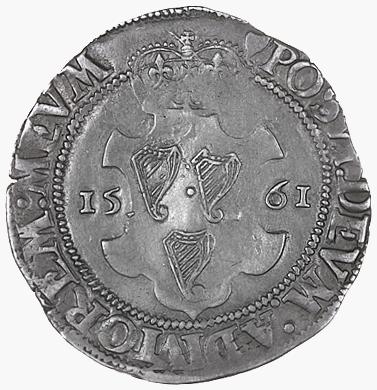
Fine silver shilling of of Elizabeth I minted minted in 1561
Later issues were heavily debased
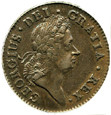
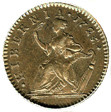
The notorious Wood's halfpenny from the reign of George I produced under a patent granted in 1722
These were later withcdrawn and
sent to the American colonies where they circulated for a number of years.
After the last halfpenny and farthing coins of George II dated 1760 and the "Voce Populi" tokens there followed just two issues of halfpennies early in the reign of George III (one in 1766 and another in 1769), each amounting to around 5 million coins. These provided only temporary relief from the chronic shortage of copper coins, a situation paralleled in the rest of the British Isles for exactly the same reasons. According the Parys Mine Company of Anglesey in Wales began the issue of copper pennies in 1787, closely followed by halfpenny tokens issued by John Wilkinson, the iron magnate. Two years later, once these tokens were seen to have gained acceptance and consequently circulated over a wide area, the Associated Irish Mine Company from Cronebane in Wicklow began to issue similar halfpenny tokers. These have a portrait of St. Patrick on the obverse, with legend CRONEBANE HALFPENNY, and the arms of the company on the reverse. These tokens were extensively counterfeited, the most common forgeries having the reverse legend changed to read "ASSOCIATED IRISH MINERS ARMS" instead of "ASSOCIATED IRISH MINE COMPANY". Other contemporary forgeries have a reverse with a seated figure and "HIBERNIA".
From 1792 onwards these tokens were supplemented by tokens from the Hibernian Mine Co. which incoporated the names of the proprietors, CAMAC KYAN & CAMAC in the reverse legend, which were also the subject of counterfeiting, so much so that the forgeries far outweigh the genuine tokens. There were three versions of these "Camacs", the original and a new design introduced in each of 1793 and 1794. Two Dublin merchants, Talbot Fyan, a grocer from Poolbeg Street, and William Parker, an ironmonger in Kennedy's Lane, and the button manufacturers Lloyd & Ridley from Harolds Cross, all issued tokens in 1794. After a gap of five years another ironmonger, William Binns of St. Stephens Green, Dublin, issued tokerns depicting the Pantheon Phusitechnikon, a large building in Dublin, with a later issue dated 1802. The last of these halfpenny token series to be issued was by Woodcock's Bank in Enniscorthy, Wexford. Although dated 1800, they were not actually minted until 1801 and probably issued the following year. (PLUS OTHER TOKENS - add here)
None of the milled coins specifically for circulation in Ireland during the late 17th Century and throughout the whole of the 18th Century included any provision for a silver coinage. The lacuna was filled by the importation and use of various foreign coins such as the Mexican "pillar" dollar, which was given a value of four shillings and ninepence5. Nor was there any provision for a gold coinage, instead using the gold pistole, valued at 21 shillings, the British guinea, valued at 26 shillings, and the Portuguese four escudos, given a value of £4. The so-called Northumberland shilling, minted in London in 1763 and distributed in Dublin by the Earl of Northumberland when he became Lord Lieutenant, was not specifically for Ireland and in any case, made little difference to the situation regarding a precious metal coinage since it was hoarded and rapidly vanished from circulation6. Ireland had to wait until 1804, when, in order to rectify matters, the Bank of Ireland issued a large silver token which they valued at six shillings. These were minted by Matthedw Boulton at the Soho mint in England, restruck on old Spanish and Spanish-American eight real pieces7. This exceeded their intrinsic value and was intended to prevent the coins being exported for profit.
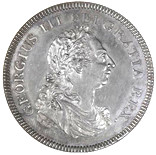
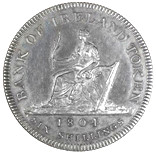
Six shillings silver token issued by the Bank of Ireland
Sometimes traces of the original coin can be seen, from which it can be shown that despite the 1804 date they must have been struck some time later.
The Bank of Ireland followed this six shilling token with smaller silver denominations of ten and five pence, issued in 1805 and 1806, and a thirty pence token in 1808. These had the portrait of George III on the obverse and the words BANK TOKEN TEN PENCE IRISH or BANK TOKEN FIVE PENCE IRISH above the date, enclosed in a wreath. According to the Act authorising these smaller tokens, they were all supposed to be dated 1805 irrespective of when they were made but due to an oversight, the Royal Mint omitted to inform the die sinkers and so a a large number were issued dated 1806. These are much rarer than the ones dated 1805. A thirty pence token was issued in 1808. The reverse of this featured a seated figure of Hibernia, with the words BANK TOKEN either side and XXX PENCE IRISH in the exergue. Finally, there was a further ten pence token issued in 1813 with a new portait bust of George III and reverse BANK TOKEN 10 PENCE IRISH . Following the Great Recoinage of 1816, all these silver tokens were withdrawn.
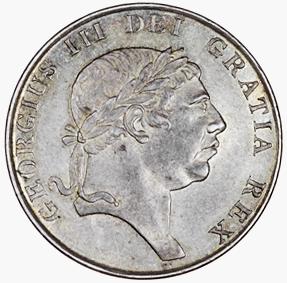

Bank of Ireland ten pence silver token issued in 1813
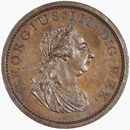
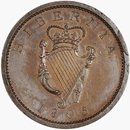
George III copper penny issued in 1804
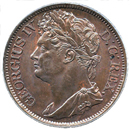
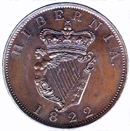
George IV copper penny issued in 1822
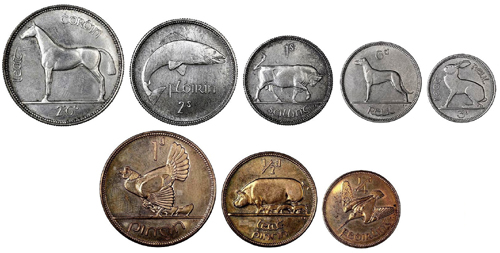
The complete set of Irish Free State coins minted in 1928
Top row: Halfcrown, florin, shilling, sixpence and threepence
Bottom row: Penny, halfpenny and farthing
NOTES:
1. An attitude shared by the Church
at the time, who voiced the opinion that the people of Ireland were mostly illiterate
pagan savages. The economy of Ireland had also suffered particularly during the latter half of the 14th
Century with the advent of the Black Death.
2. These were minted at the time of the War of the Roses and consequently were anonymous
issues, without the king’s name on them.
3. The “Princes in the Tower”.
4. Or Richard Symonds, depending on the source.
5. Later raised to five shillings and fourpence.
6. To be fair, the same thing happened in Britain. The early reign of George III (1760-1820) was noted for the absence of a
silver coinage, save for the shillings and sixpences from 1787 which were also hoarded.
7. A similar expedient was adopted for the Bank of England dollar, which was similar in design and valued at five shillings.
Amendments:
Page introduced 9 July 2008